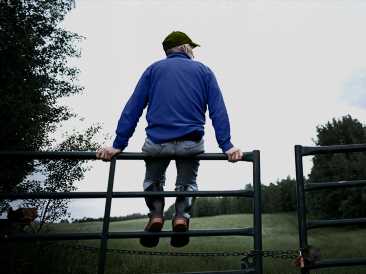
- A study has examined people’s attitudes toward vaccines at various stages of the COVID-19 pandemic.
- The study focuses on older adults, as they are more likely to experience severe illness and death related to COVID-19.
- The authors conclude that in future pandemics, public health officials should focus on addressing vaccine ambivalence among people they describe as “fence-sitters.”
A new study, published in the Journal of Community Health, emphasizes the importance of outreach to people who have mixed feelings about getting vaccinated.
The study looked at the attitudes of participants aged 55 years and older about vaccines at different stages of the COVID-19 pandemic.
The researchers accessed data from the COVID-19 Coping Study to identify people in the United States who were either receptive, ambivalent, or against getting vaccinated against the disease.
COVID-19 vaccine take-up
To date, the Centers for Disease Control and Prevention (CDC) report that 75% of the adult population is fully vaccinated, having received two doses of an mRNA vaccine or one dose of a single-dose vaccine.
However, though studies indicate that receiving a booster dose reduces severe illness by 92%, the CDC reports that only 47.1% of adults who are fully vaccinated have received at least one of these additional doses.
Studying vaccine hesitancy
The study utilized data collected from April 2020 to May 2021 from 2,358 participants. Some of the study’s questions concerned social distancing, wearing masks, and feelings about vaccines.
The researchers looked at vaccine-related responses early in the pandemic, around the time when vaccines were becoming available, and then in the late spring of 2021, when vaccines were readily available.
Based on the responses, the researchers classified the participants into three groups:
- vaccine acceptors
- vaccine ambivalent
- vaccine rejectors
The data collected early in the pandemic indicated that 88.9% of the participants were acceptors, 8.6% were ambivalent, and 2.5% were rejectors.
The last set of responses indicated that 90.7% of acceptors had received the vaccine, 62.4% of the ambivalent participants had received the vaccine, and 30.7% of the rejectors had received the vaccine.
Dr. Katharina Hauck spoke with Medical News Today about the findings. Dr. Hauck is a professor of health economics and deputy director of the Abdul Latif Jameel Institute for Disease and Emergency Analytics, within the School of Public Health at Imperial College London.
“This is an interesting but largely descriptive analysis of sociodemographic factors associated with vaccine hesitancy in older individuals,” said Dr. Hauck. “The strength of the paper — and most interesting finding to me — is the analysis of prior vaccine attitudes with the later observation of actual decision to get vaccinated.”
“The findings are good news,” Dr. Hauck continued. “The authors mainly focus on the high proportion of vaccine ambivalents who get vaccinated in the end — 62% — but I find equally noteworthy that 30% of vaccine rejectors get vaccinated in the end.”
Implications
The findings of the study could help doctors and others in public health encourage take-up of future vaccines.
“These findings have important implications for public health messaging and planning. Fence-sitters are probably the people who are easiest to target for certain health promotions,” says lead study author Dr. Abram Wagner, an assistant professor of epidemiology at the University of Michigan, in Ann Arbor.
“The next time that we need to introduce a new vaccine into the population, we could quickly identify who these fence-sitters are,” Dr. Wagner continues. “We followed them for a period of time, and there was a strong relationship between their hesitancy in how we group them and their actual behaviors.”
The authors note that ambivalence among some people may have stemmed from medical discrimination and that community leaders could reach this group. They suggest that such leaders could also help encourage “risk reduction behaviors.”
Dr. Nicole Hassoun, a professor at Binghamton University, in New York, and head of the Global Health Impact project, spoke with MNT about the paper.
“To overcome vaccine hesitancy, it may also be important to make sure that people of all racial, ethnic, and cultural backgrounds, as well as women and other disadvantaged groups, are included in clinical trials,” said Dr. Hassoun. “This is important for scientific validity but potentially also for encouraging trust in the approval process.”
Limitations of the study
The authors note that the manner used to recruit the participants may have been limiting. The people who participated signed up either online or through a mailer.
“Non-probability sampling strategy means that our sample is not population-representative,” the authors write.
Despite this, they say that the study included people from all 50 states and the District of Columbia, so the geographic representation was strong.
Dr. Hauck pointed out that the authors were unable to determine the factors that influenced the decision to get vaccinated.
“So overall, the conclusion that ‘targeting the vaccine ambivalent may be an efficient way of increasing vax coverage’ is not justified by the findings, in my opinion,” she said. “Many factors have likely contributed to positive vaccine decisions. The authors did not evaluate the causal impact of an intervention targeted at the vaccine ambivalent, which would be needed to make that statement.”
Dr. Hassoun also expressed concern about the results of the study.
“My main worry about the study is that it doesn’t have a representative — nor even a particularly large — sample, even of the elderly population in the U.S., and the internet platform makes it particularly unlikely that it represents the elderly population well.”
Because vaccine hesitancy can significantly damage public health, investigating ways to tackle it before the next pandemic is of paramount importance.
Source: Read Full Article
